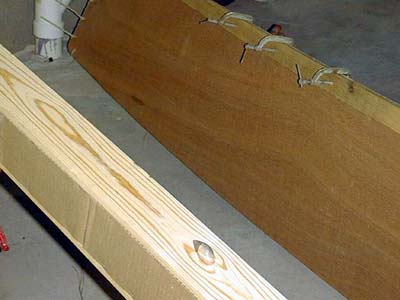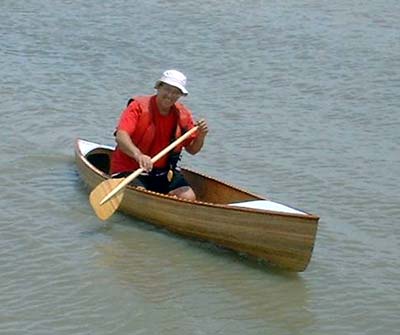It is all Shorty’s fault. I had been cogitating, ruminating
and generally wasting time thinking about Proas for a while, thinking
that a Pacific style Proa would be an ideal trailer sailor type
craft for the shallow waters I’m most familiar with. Problem
is, there are way too many unknowns and a serious shortage of
rules of thumb for such an unconventional craft. To whittle down
on the unknowns, you’ve got to build something and try it
out. But what to build? Sure don’t want to spend too much
time and effort on a purely experimental boat, but there aren’t
many guidelines for purely experimental boats either. I had been
considering building a boat to the old 3 meter multihull rules,
but a 10’ boat is pretty darn short for a boat that is trying
to find the path to easy speed.
Then along comes Shorty’s $50 sailboat
race with just the right combination of restraints
plus the additional challenge of doing it for less than $50.00.
A couple of quick iterations of materials/cost settled down that
the boat had to use no more than 2 sheets of plywood (5.2mm luan
underlayment). Fifty bucks vanish pretty quickly in all the little
odds and ends. Fortunately, there were two semi loopholes in the
rules. First I already had a mast (12’ piece of 2”
aluminum tubing from a previous sailing canoe) and a $2.00 finish
allowance was pretty generous for a boat that’s going to
have a lot of surface area.
Fourteen feet long overall and an eight-foot long float, two
sheets of plywood disappear pretty quickly. Instead of the precise
mathematical dance (with plenty of guesswork) involved in designing
a stripper canoe, It was time to use scissors and cardboard.

The first attempt in the background had a pretty clunky looking
hull but the float looked pretty good. So lets try a vee shaped
main hull so no plywood needs to be ‘wasted’ in bulkheads.
The result in the foreground looked good and appeared would have
enough floatation, barely. The architect’s scale holding
the hull and float up was the serendipitous hint to use a single
crossbeam that you could ride like a broomstick and use less material.
Another iteration of material pricing and things are looking good,
but there’s not enough plywood for the shear webs in the
crossbeam, but I’ve got some heavy duty cardboard boxes
I’d snatched from the trash that should work fine as long
as it doesn’t get wet. The design is done and under budget
(click here for spreadsheet)
time to build.

(click image to enlarge)
Being one of those projects that might should be lost in the
mist of time, I didn’t take any pictures during construction
except for the one time there was a snail on the crossbeam, which
might have been a sign from somewhere.

Building actually went pretty quickly, there’s not a lot
of material in a $50 boat. Stick a few pieces together, then scratch
head awhile then eyeball the next pieces together. All the while
coasting on the edge of DT’s building a boat without a single
drop of epoxy! A couple of weekends and its done, rigged in the
backyard to get the right lengths on the trucker knot turnbuckles
in the yellow poly rigging (proper yachtsmen are probably turning
over in their graves). What to call a very unserious boat that
goes either way? ACDC naturally, with a backup name of cardboard
broomstick
The first outing and race are covered elsewhere, suffice to say
Ken Abrahams beat me and everyone else soundly in a very small
kayak (little material) with an umbrella (the Mary Poppins gambit)
showing one more time the absolute superiority of the simple solution.
ACDC floated, leaked a little and would have been a disaster
in any kind of wind. Steering oar / broomstick was wayyy tooo
small. Had the oar been larger it would have destroyed the oarlocks.
The sail shunting scheme was an open invitation for Murphy to
make his season at least, if not the year (but it was simple).
Anyway for less than fifty dollars I’ve got the framework
to do some semiserious experimenting.
May 22-23, I took ACDC, the previously $50 proa and a new almost
finished stripper canoe to the Duckworks
Messabout on Magnolia Beach, near Port Lavaca, TX.
Turnout and weather were good, though the 15 gusting to 20 felt
like 20 gusting to 30. Whatever the windspeed, it was blowing
offshore so the water was smooth for at least 100-200 yards offshore.
ACDC now has a slider assembly like a drafters parallel bar (remember
those?) to change the tack from one side of the biaxial (also
known as Bolger, Xmas tree, AYRS…..) sail to the other.
The cardboard shearwebs in the crossbeam have been replaced with
plywood. There is a stronger oar and oar sockets. A padded seat
has been added. A 6” strip of 12 oz biaxial glass has been
added down the keel line. There is a certain perverse pleasure
in the knowledge that any finishing done to date has been done
with a belt sander.
ACDC waits patiently for me to screw up enough courage to hop
on a boat held together with bailing twine after reading Wade
Tarzia’s report
in the proa_file group written from the hospital emergency room.

After paddling and sailing on everything in sight I finally
ran out of excuses and slid ACDC into the water.

Damn that boat is fast, accelerates quickly and tracks like its
on rails. Tracking straight is a very good thing. My carefully
thought out oar ball socket isn’t working at all and I’m
flailing the steering oar around every which way trying to steer
the boat and finally gain some control jamming the oar into the
face (wrong) side of the socket and keeping it in place by brute
force. Running parallel to shore, I pinch into the wind a bit
to slow down and try to shunt.
Shunting works, sort of. The shunting line slides the tack to
the other side of the sail quickly and easily, but somehow I am
backwinded and moving at a fair clip with the float completely
under water. Grab the oar in both hands and paddle like mad to
drag the boat around 180 degrees and sail back to shore.

This picture shows ACDC in a resting position,
which allows water to drain out of the float.
Safely on shore, it's time to think just a bit about what happened.
Everything happened fast. I haven’t done much sailing for
many years, just paddling and water skiing, so I don’t have
any automatic reactions to unlearn. The problem is my reactions
are just slow. In any event I’m grateful, and surprised,
the boat got back to shore all in one piece. Don’t think
I want to know how slack the (nominal) windward stay was while
we were running backwards, or more importantly, how close the
mast was to going over center so I could try to top Wades tale.
The fundamental principle of spreading the loads out wherever
possible, to keep stresses low, seems to work.
After resting a bit, I decide to take ACDC out again and try
to learn more. The wind still seems strong to me, but ACDC hadn’t
really been in any trouble until backwinded. Plus, I couldn’t
see any easy way to reef a Tyvek sail without shutting the window
in the sail, which would be courting disaster even with the roll
of duct tape strapped to the mast to appease Murphy.
Second time out with just a little bit less adrenaline and everything
starts out fine not fighting the oar quite as much and we are
still fast and shunt a couple of times without incidence. Then
the shunt line jams at one of the turning blocks and we are backwinded
again. Rather than fight it again, I drop the sail and skull,
and skull, and skull to shore. Walking up the shore with ACDC
following on a short leash might seem disheartening or even disappointing
to some, but in this case, its not bad duty for a dirty old man.
Two times out and backwinded both times, Pacific Proas aren’t
supposed to do this. May be the very deep vee of the main hull
is over powering the float and spinning the boat around as it
drifts downwind, or it may just be operator error. Time will tell,
but the day is over.

Early next morning. A little less wind and variable, time to
try again before packing up and heading home. Much better, the
boat glides away from shore like it is on wings and most importantly,
I find that the boat responds quickly to just a little twist of
the oar, no more pushing and pulling trying to horse the boat
around, it only needs to be nudged a bit. This is fun. I run along
the beach pinching up at times to see how the boat goes to windward
(slowly) but it will stay in control far further that I would
have expected. Then fall off and accelerate again. Shunt and head
back to campsite, a little closer to a run but everything still
under control, along with a feeling my sail trimming skills need
a lot of work.
Back at camp, a cup of coffee and strut a bit, then take ACDC
out one last time. Once again, we are gliding and it is great,
all I have to do is learn the finer points handling the boat.
We, as in boat and I, run along the beach again and get up to
where the beach turns more Westerly and we aren’t ready
to venture farther afield yet so its time to shunt again. Jammed
shunt line again. I pinch in again and get up to shore before
the point and unjamb the line. Maybe I should have called ACDC
“Goes where pointed”. The wind has shifted a little
and its difficult to get backed off the beach far enough to turn
a bit before the boat runs back up on shore, but we make it. Back
along the beach to camp, reflecting on how the second time out
each day seems to always have more problems than the first.
What to do next? Don’t know for sure. I think there’s
a way to rig the oar so I can let go for a minute with out disaster
happening. The shunt line needs to be larger diameter and it’s
time to clean up some of the connections so the boat can be rigged
a little quicker, although the boat assembles and disassembles
pretty quickly now. The oarblade is still a little too flexible
even with a layer of 5oz glass both sides. I will trim the size
down just a bit and cut a scallop out of the end before adding
another layer of glass. Slather some latex on the bare wood pieces
and oil finish the closet rod sliders. Better hold down or permanently
fasten seat. Rig a little sheave on halyard or double up to get
a 2/1 purchase for raising sail. Big thing is to get some stick
time on the boat, learn to sail it and see what works well and
what doesn’t. I think the main hull wants to be shallower
with less wetted surface with a float that provides most of the
leeway resistance, but am afraid yet to mess with something that
appears to be working. ACDC is about as big as I would ever want
to go for a cartop (uh, truckrack) boat. For an easy to use boat,
a 20 something pound solo canoe (picture below) has no peer and
is what I’ll carry to the water most often, which cuts down
on stick time, but hey it’s a hobby.

EasyB
Skip Johnson

|

